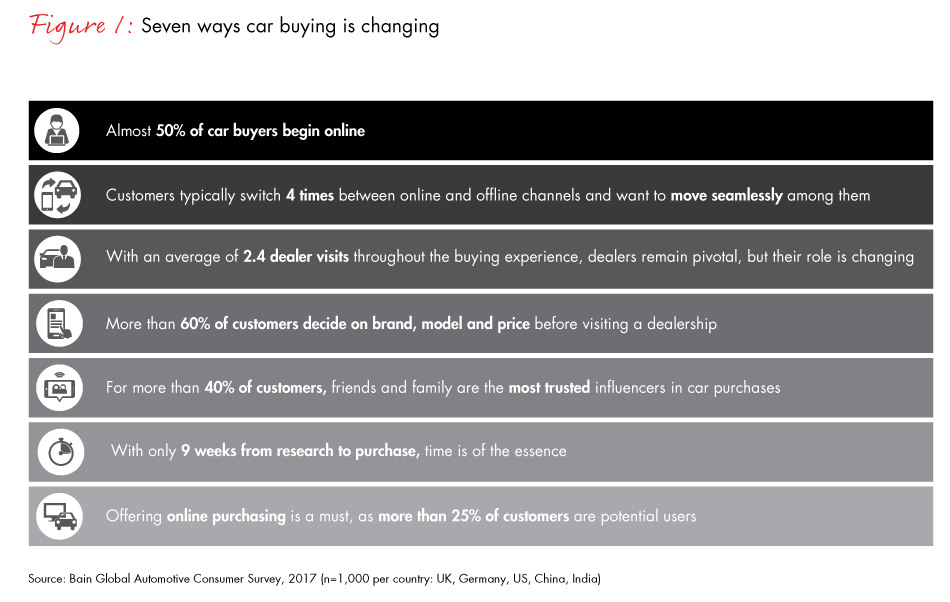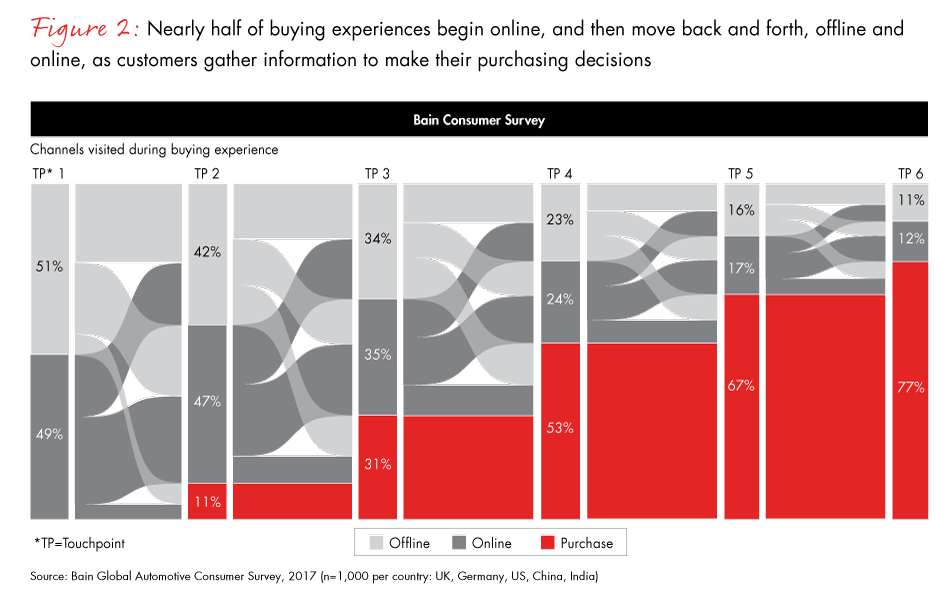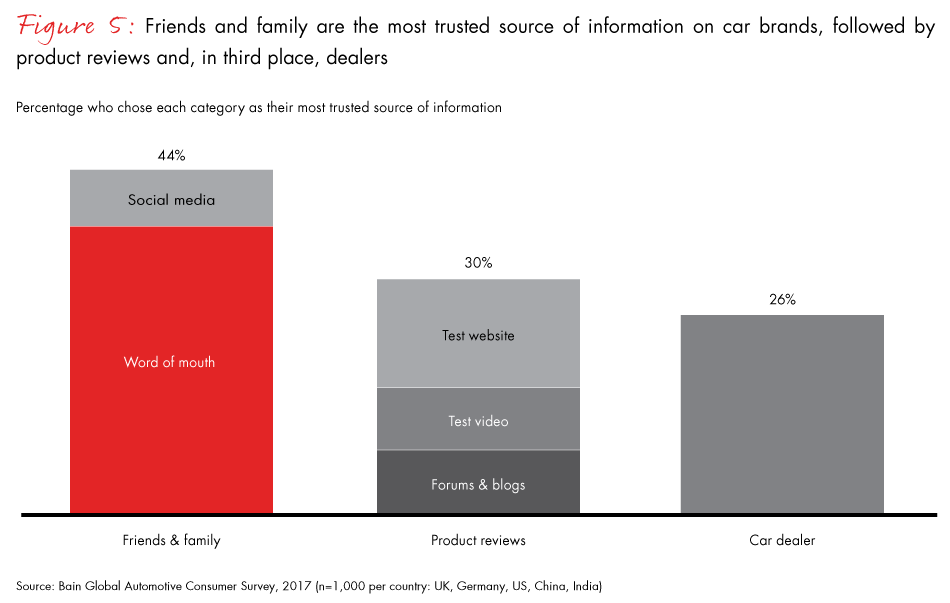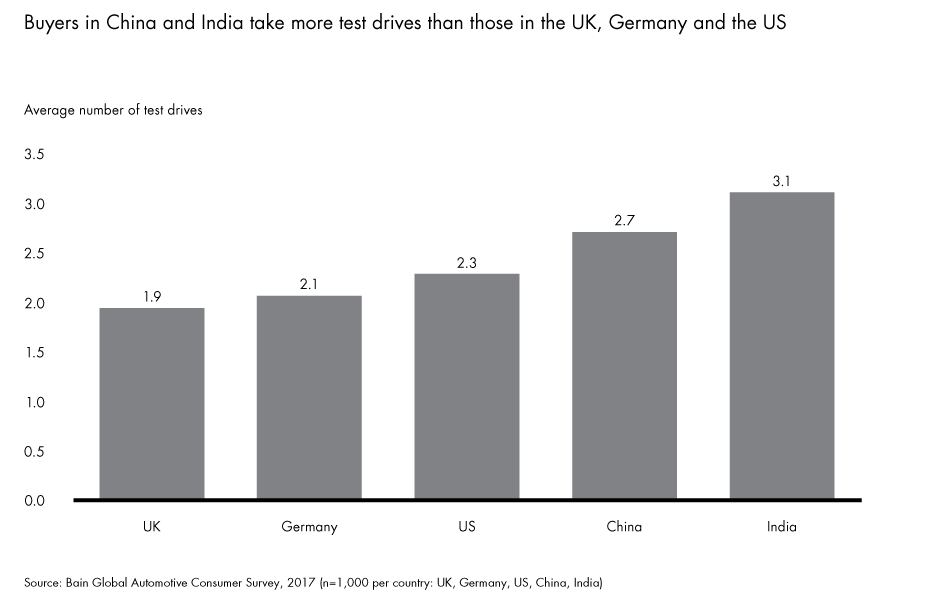Brief
 }
}
Technological innovations in automobiles have advanced rapidly in recent years, improving safety, performance and reliability. Electric drivetrains are becoming mainstream, and the advent of autonomous vehicles is only a few years away.
By contrast, the dealer organizations at the front line have remained rather conventional in their approach. Even with recent attempts to streamline sales and reduce the number of dealers, the retail model has seen no radical changes in services, customer experience or cost. Today, sales, marketing and distribution still consume a significant share of the revenue from each vehicle sold. A few new entrants—most prominently Tesla, which started with a clean sheet—have built direct, online-heavy retail systems, but most of the industry is saddled with legacy dealer networks and contractual obligations.
However, car-buying behavior is changing in ways that will force radical and disruptive change in auto sales. Digital natives are becoming mainstream car buyers with completely new expectations, and older generations are picking up new habits. Conditioned by Amazon and other online experiences, car buyers increasingly follow omnichannel customer episodes: They research, select and buy cars in different ways than their non-digital predecessors, and increasingly they expect the same capabilities and service quality when shopping for cars as they experience in other aspects of their digital lives.
Fulfilling the needs of these consumers may appear straightforward at first, but building the necessary capabilities requires significant effort. It goes far beyond websites, online configurators and mobile apps and requires a considerable transformation of the model to deliver a true omnichannel customer experience.
To get there, automakers and dealers will need a deep understanding of the evolving nature of car-buying behavior, in order to begin reshaping their approach. Bain’s recent study of more than 5,000 car buyers from five of the largest car markets (China, Germany, India, the UK and the US) offers a penetrating view of these new customer buying behaviors (see Figure 1). And automakers and car dealers will need to adapt quickly and track these changes to build a customer-centric ecosystem.

Beyond these globally consistent findings, several regional and country specifics surface, highlighting the need for locally targeted sales approaches. For example, in India social media is becoming critical, while in China it’s important to show up at fairs and other events—which is much less important in Germany or in the UK. (See the sidebar “Regional differences emerge.”) Even as customers shift toward digital and omnichannel, they maintain and develop new local preferences. In addition, we found several differences between premium customers and those buying less expensive cars.
Developing new omnichannel sales approaches will be essential to remaining competitive: Automakers that adapt well will not only serve their customers better, but may also reduce their sales and marketing costs. While the full potential will vary, Bain estimates that up to a fifth of these costs can be cut with an integrated, seamless model. Similar cost reduction potential is hard to find elsewhere along the automotive value chain.

The Future of Car Sales Is Omnichannel
Car-buying behavior is changing, and almost 50% of buyers begin online. Here's how dealers and automakers can respond.
A case for disruptive change: The new omnichannel experience
A typical car buyer’s experience traverses several different digital channels (websites and mobile apps) and visits to dealerships or special events, while the buyer gathers information, test-drives, configures and ultimately buys a car.
1. Almost 50% of car buyers begin online. Rather than taking their family to a dealership on a weekend to look at cars as their parents might have done, nearly half of all customers globally and up to 60% of customers in the UK now begin online— mostly from the office or in the evenings in the comfort of their living rooms (see Figure 2). The share of online touchpoints stays high throughout the purchase experience and will continue to increase.

2. Customers switch between online and offline channels and want to move seamlessly among them. While online is becoming the most important starting point, buying experiences are still not pure digital plays. Customers typically shift between different online and offline channels at least four times, and they expect their preferences to carry across channel boundaries so they don’t have to repeat them again and again.
3. Dealers remain pivotal, but their role is changing. Although buyers are becoming more comfortable researching, configuring and even buying cars online, physical dealers remain important in most purchase episodes. Across markets, car buyers visit physical car dealers an average of 2.4 times during the purchase episode—down in recent years, but still significant. Most buyers still prefer to complete complex tasks like the final configuration and purchase in person at the dealership.
Dealers also earned higher ratingsi for the configuration process, garnering a Net Promoter Score® of 41. However, digital channels are right on their heels with a Net Promoter Score of 38 for online configuration and 38 through an app (see Figure 3). Test drives also remain an important benefit of dealerships: Most buyers said they would not buy a car without driving it, although some are now open to virtual-reality test drives. But that leaves more than one-third of today’s buyers willing to complete their purchase without a test drive, further increasing the importance of digital channels.

4. More than 60% of customers decide on brand, model and price before visiting a dealership. Increasingly, customers know exactly what brand and model they want, and how much they want to pay, before visiting a dealership (see Figure 4). Customers spend a significant amount of time researching their purchase online, but most still visit dealers for a test drive, final configuration and the purchase.

Automakers and dealers should not misinterpret customers’ predetermination of a brand and model as indicating overly strong brand loyalty. Actually, the opposite is true. Car customers’ loyalty has been decreasing over the past decade, and prospective buyers are much more open to switching brand or model for a better match or package.
5. Friends and family are important influencers in car purchases. Our survey found that friends, family and colleagues are the most influential and trusted sources when deciding on a new car (see Figure 5). Among survey respondents, 44% of buyers follow recommendations they get in their private environment. Another 30% rely on online product reviews and test sites, which continue to gain influence, increase information transparency and simplify comparisons across brands. Dealers placed third, with only 26% of buyers calling them their most trusted channel.

Given the importance of personal recommendations, automakers need to focus on building “promoters”—customers who are so satisfied with their purchase that they will strongly recommend it to their friends, family and colleagues. Creating promoters pays off twice: Not only do they show higher rates of loyalty and repurchase, they also create referrals and positive word of mouth that can influence other buyers. A comprehensive strategy for creating promoters goes beyond selling great cars and offering good service. Increasingly, automakers need to complement these achievements with an inspiring digital ecosystem of product information and compelling offers.
6. Time is of the essence; the window of consideration is short. The average shopping episode, from initial research to purchase, is only about nine weeks.
Many customers don’t contact dealers until late in the process. But automakers and dealers who wait this long may be too late. They need to find ways to engage with customers earlier (sometimes even before they think about buying a car) and reach a wider audience—not only existing customers, but new ones as well.
Automakers and dealers will have to find ways to connect with their most promising prospects. Daimler has a Mercedes Me app and corresponding Mercedes Me stores in cities like Berlin, Hong Kong and Tokyo, which host events to showcase the brand, in locations where sales are not the focus. (See the sidebar “Premium vs. mass-market buyers” for more insights on premium buyers.)
There are many ways digitalization can help automakers and sellers stay relevant. The right analytics will help connect automakers with online car shoppers and smooth introductions—perhaps through an invitation to the automaker’s Instagram account or a direct offer for a test drive sent through the app when a shopper is in the vicinity of a physical store or dealership.
7. Offering online purchasing is a must, as more than 25% of customers are potential users.ii Only about 2% of customers in our global research sample have bought a new car online, which means they have signed contracts and paid without visiting the dealer.
Given the infrequent opportunities to buy online today, this low percentage isn’t surprising. We expect this share to increase significantly: Up to 65% of our survey buyers said they would consider buying online in the future, with buyers in India most open to online buying and those in the UK least open at 50%. Even though intent does not always translate to action and regulatory hurdles can get in the way, we expect more than 25% of customers could become potential online buyers over the next years (see Figure 6).

The omnichannel sales imperative
Given these seven findings about the changing nature of the car buyer’s experience, how should automakers and dealers approach the challenge of developing omnichannel sales excellence? Future leaders will need to build strengths in five critical areas of the sales experience.
- Find new ways to appeal to buyers. Increasingly, car buyers expect the same levels of innovation and personalization they find in online consumer services. To meet those expectations, automakers and dealers need a deeper understanding of their customers. As more of the purchase episode takes place online, automakers and dealers need to actively manage their online presence, including social media. Even among less digitally savvy customers, traditional large-lot dealerships may not generate as much interest as small showrooms downtown or pop-up “brand experiences” at special events. Gaining a deeper understanding of customer preferences will help automakers and dealers develop new features for the customer experience, including virtual test drives, augmented-reality views of a new car’s features or new driver health and wellness features. (See the sidebar “Creating the prerequisites: Implications for automakers.”)
- Manage channel boundaries effectively. Every time customers switch from one channel to another, automakers and dealers risk losing preferences or other data—which could result in frustration or loss of those customers. To avoid that, they will have to find ways to bridge channels, creating a true and seamless omnichannel experience. A customer might expect to start a configuration in the app, fine-tune it with the help of an online sales agent in a chat, share and discuss it with friends on social media and post a picture of herself in the new car online to gauge reaction. Some customers might be receptive to an invitation to come into a dealership for a test drive. Ensuring that customers’ preferences and history are available across channels requires not only the connection of IT systems, but also the cooperation of all the players in the ecosystem.
- Build analytic capabilities to generate valuable insights. Learning more about customers by analyzing data allows automakers and dealers to communicate more effectively and create more compelling offers. Increasingly, the ability to generate meaningful insights from information available at the dealer, online and from connected vehicles will separate winners from losers. For example, car owners who play music at top volume might be receptive to upgrades for their sound systems. Those who drive mostly at night might be interested in stronger LED headlights or a retrofit preheater if sensors indicate frequent cold starts in wintertime.
- Bring buyers into the ecosystem. Customer interactions used to be limited to a few moments before, during and after the sale or service event. But an omnichannel experience supports a long-term relationship with customers over the life of the vehicle and beyond. Automakers can take their brand experience to a new dimension, creating new opportunities to learn more about customers and ensure they are present when buyers make purchase decisions. Apps that manage interactions with the vehicle— locking or unlocking remotely, monitoring maintenance and communicating with the dealer’s service department—are already in the field. Buyers who use these apps remain within the automaker’s ecosystem, allowing the automaker and dealer to stay in touch, develop the customer relationship and present new offers.
- Adapt the dealer network. As more customer episodes move online, dealer networks will see less use. Automakers will need to take an active role in shaping the contours of their future dealer networks, which are likely to comprise fewer dealer partners and outlets, especially in mature markets. At the same time, new outlets such as downtown showrooms and pop-up brand experiences will require considerable thought and investment.
As in any industry, the transition from a traditional to an omnichannel sales model will require major changes. The leaders that embrace change, find ways to innovate and invest in omnichannel relationships with buyers will build a lasting competitive advantage.
Regional differences emerge
Although the shift toward digital and omnichannel is global, regional differences are appearing:
- Where buying begins. Customers in developing economies like China and India generally show a strong affinity for online touchpoints, but they tend to start their buying episodes offline, and more than one-third start at the dealer. In the US, 54% of episodes start online, and in the UK the percentage is nearer 60%.
- Number of touchpoints. Car buyers in India and China have more touchpoints throughout (about 7.5 and 7 on average, respectively—compared with about 6 in mature markets) and assign different importance to the individual touchpoints.
- Number of test drives. Buyers in China and India do more test drives before buying a car (about three on average) compared with buyers in Germany, the UK and the US, who average about two test drives (see figure).
- Predetermination. Customers in China and India are more likely to know what they want before they go to a dealer to purchase, with up to 75% of all premium customers saying they were fully determined on brand, model and price before visiting the dealer.
- Speed of decision. Buyers in the US are fastest to decide (8 weeks on average, 51% in less than a month); Germans take more time (10 weeks, with 47% taking between one and three months), followed by Indians (11 weeks, with 54% taking between one and three months). In developed markets, younger buyers take longer to decide, while in China and India differences among age groups were less significant.
- Configuration. Across the countries we surveyed, most buyers prefer to configure their cars with the dealers. In general, buyers were less satisfied with apps, although Americans find apps the best ways to configure cars—and UK buyers like apps the least of all options.

Premium vs. mass-market buyers
Our research identified several ways that premium buyers have different experiences than customers in the mass-market segments.
- More interactions. Premium car customers have about 25% more interactions during their buying episodes than mass-market customers. This should encourage premium automakers to develop more robust ecosystems to guide customers through the car-buying episode. Consequently, non-premium carmakers will want to exert greater influence on customers in the few touchpoints they have.
- More determined. Non-premium customers are less decided on specific brands, with about 10% to 15% of non-premium buyers in Germany, the UK and the US completely open to brands, compared with only about 5% of premium buyers who are similarly flexible.
- Fewer test drives. Customers in the non-premium segment do more test drives, buy more stock vehicles and rely more heavily on advice from the dealer—perhaps because they are more price sensitive and thus more likely to accept the most attractive offer.
Creating the prerequisites: Implications for automakers
Nearly all automakers and dealer groups have made some initial steps in the omnichannel direction in recent years. In the premium segment, Mercedes-Benz received significant praise for the launch of its Mercedes Me ecosystem, which combines physical stores and an app that offers car-related services, such as remotely locking and unlocking the car, and an entire portfolio of complementary services related to fitness and well-being. In the mass consumer segment, Hyundai is pioneering its Click to Buy platform, which allows customers to lease or buy a car online, as well as promoting its cooperation with Rockar, a dealer known for an original sales approach that combines online presence with innovative retail locations in premium shopping malls.
These are valuable efforts, but they are still limited to a relatively small scale. With more direct customer interaction and more sales online, automakers and dealers will be forced to rethink and upgrade their entire sales operating model, focusing on five dimensions in particular.
- Create new functions and roles. To meet the demands of an omnichannel sales model, automakers and dealers will need to fill new roles and staff them with skilled employees.
- Upgrade core processes. Fulfilling customers’ requirements will require new processes, including direct customer contact management (that is, channeling requests to the right person, no matter which channel they come in through).
- Update the organizational structure. Because an omnichannel sales process crosses functional boundaries and requires close collaboration across functions and business units, automakers will need to restructure some parts of the organization, breaking down silos and flattening some layers, in order to serve customers across the entire purchase episode.
- Implement a new governance and steering model. Automakers will need to broaden their focus beyond volumes and margins to include more operational aspects in their models for steering their sales process. New elements such as campaigns, communication content and, most important the consistency of retail prices across channels will need to be coordinated to ensure seamless cross-channel experiences.
- Adapt incentive schemes. To prevent undesired competition between channels, incentive schemes will need to be adapted. For example, dealers could be rewarded for getting a customer to buy online (saving on system costs) or register with an online service (tying customers to the brand), or for helping an online customer with a special configuration question (strengthening direct sales).
In order to achieve the next-generation sales model, automakers will need to build new capabilities. They will need to attract new talent to create exciting digital experiences and customer episodes, as well as upgrade their IT capabilities to provide the apps and tools required to operate in an omnichannel world. Building these digital capabilities will not only help serve customers better, but could also help automakers cut their sales and marketing costs significantly.
i We measure customer loyalty with the Net Promoter System®, which asks for a customer’s willingness to recommend a company or product on a scale from 0 to 10. The Net Promoter Score® is then calculated as the percentage of promoters (respondents giving a 9 or 10) minus the percentage of detractors (respondents giving a score between 0 and 6).
ii In this article, we refer to an online purchase as a deal closed online—that is, the binding contractual commitment and payment are executed online. The customer may have test-driven a car at the dealer and may pick it up there later, but the deal is closed online.
The authors would like to thank Michael Trenkwalder, a manager in Bain’s Munich office, for his contributions to this work.
Net Promoter®, Net Promoter System®, Net Promoter Score® and NPS® are registered trademarks of Bain & Company, Inc., Fred Reichheld and Satmetrix Systems, Inc.






